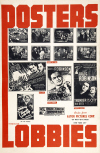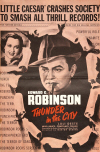
 Edward G Robinson is remembered for playing snarling gangsters
and other tough guys, but in real life he was a very cultured man, a
collector of art and antiques. (Robinson acquired a Van Gogh before
that artist was well-known.) Thunder in the City is a
low-budget film that Robinson made in England, playing a fairly
normal person for once. I wanted to like this movie, as it
brought back memories for me of the one occasion when I met Robinson
(in London, when he was buying antiques in the Portobello Road).
Sadly, despite the presence of an excellent cast and a good
performance by Robinson, this film is not very entertaining.
Edward G Robinson is remembered for playing snarling gangsters
and other tough guys, but in real life he was a very cultured man, a
collector of art and antiques. (Robinson acquired a Van Gogh before
that artist was well-known.) Thunder in the City is a
low-budget film that Robinson made in England, playing a fairly
normal person for once. I wanted to like this movie, as it
brought back memories for me of the one occasion when I met Robinson
(in London, when he was buying antiques in the Portobello Road).
Sadly, despite the presence of an excellent cast and a good
performance by Robinson, this film is not very entertaining.
Despite its low budget, Thunder in
the City opens with an extremely impressive montage by Ned Mann,
and offers several other impressive montages throughout the movie.
Those montages are the best things in this film. The single
biggest problem is that Thunder in the City (with its overly
dramatic title) can't seem to figure out what sort of movie it wants
to be. This material has the general pacing and feel of a
comedy, but it isn't funny, and it's not quite engaging enough to be
a drama. A previous IMDB poster has compared this movie to
Beat the Devil. Sorry, but Thunder in the City
hasn't got one percent of the wit of that film.
Robinson takes centre stage as Dan Armstrong, a high-pressure
publicity agent in charge of the New York campaign for a motorcar
called the Straight 8. (He doesn't seem to be bothered that
the car has an illegible logo.) When the ad campaign fizzles,
Armstrong's bosses pressure him into resigning because they haven't
the bottle to sack him outright. One of Armstrong's bosses
tells him that he could learn from the example of the English, who
were so efficient in acquiring Suez. (No comment.) This
prompts Armstrong to recall his prankster grandfather, an Englishman
who fled to America in disgrace after he stole a mummy out of the
British Museum and smuggled it into the front bench in the House of
Lords. Now, Armstrong conveniently recalls that he still has
relatives in England, and even though he's never met them he assumes
they'll be delighted if he pops round for a visit. (Frankly,
Edward G Robinson doesn't look as if his ancestors came from the
sceptered isle.)
Armstrong's relations are the Duke and
Duchess of Glenarvon, lounging about in Challoner Hall, which has
been the family home for 20 generations. They've got titles
and bloodlines but no money. (This is the most plausible part of the
movie.) When they learn that Armstrong is coming to visit, they
assume he's wealthy and that he plans to buy Challoner Hall.
Young relative Dolly eagerly hopes that she'll be able to land a
rich husband. (Dolly is played by Elizabeth Inglis, who would
soon land a very rich husband indeed; in real life, she married the
president of NBC television and became the mother of Sigourney
Weaver.)

 When Armstrong shows up on their
doorstep, we get the usual hackneyed Our American Cousin
situations, contrasting a brash Yank with some buttoned-up British
bluebloods. When the Glenarvons inquire into the fate of
Armstrong's grandfather, Robinson has the only funny line in this
movie: "It was his ambition to be an inmate in every state in
the Union. But he died before he got to South Dakota."
When Armstrong shows up on their
doorstep, we get the usual hackneyed Our American Cousin
situations, contrasting a brash Yank with some buttoned-up British
bluebloods. When the Glenarvons inquire into the fate of
Armstrong's grandfather, Robinson has the only funny line in this
movie: "It was his ambition to be an inmate in every state in
the Union. But he died before he got to South Dakota."
Armstrong has a "meet cute" scene with
Lady Patricia: nice work by her stunt double here, as Lady Pat falls
off her horse. Lady Patricia is supposed to be an English
blueblood, but she's played by untalented Austrian actress
Luli Deste with an accent full of wienerschnitzel. There's
a line of dialogue to explain that Lady Pat has spent a lot of time
in Vienna.
Luli Deste's scenes are so painful to watch (and listen to) that
she ruins the few merits this film possesses. The movie would
have made more sense if Elizabeth Inglis and
Luli Deste had swapped roles during rehearsal.
Learning that the Glenarvons'
investments are all tied up in Rhodesian mines, Armstrong whips up a
publicity campaign for a 'miracle metal' called Magnalite (it might
as well be McGuffinite) that these mines allegedly produce.
Soon, he has a veritable South Seas Bubble on his hands, as English
working-class folk (with bad Cockney accents) queue up to invest
their savings in this sure-fire deal. (When you see Sid, tell
him not to bother.)
Speaking of bad accents, the English
actors who play Americans in this film (mostly in the early scenes)
aren't very believable. Veteran film composer Miklos Rozsa has
never impressed me, yet here he surpasses himself by bringing in
every possible musical cliché. When Robinson arrives in
England, the soundtrack plays "Land of Hope and Glory". When
he visits a funfair, the soundtrack plays 'The Loveliest Time of the
Year'...the same waltz music that shows up in almost every movie
featuring a scene at the circus or carnival. The ending of the film manages to be
very sudden and extremely muddled.
There are good things in Thunder in
the City, but they're few and far between.
Nigel Bruce gives a good performance as the Duke of Glenarvon; I
wish I could say as much for the annoying Constance Collier as his
wife. I've savoured Ralph Richardson's distinctive
performances elsewhere, but here he merely takes up space.
Fans of
Edward G Robinson who want to see this movie should be
forewarned that Robinson does nothing here that he didn't do much
more skillfully in almost any of his Hollywood films. I'll rate
Thunder in the City only 3 out of 10, mostly for those delicious
montages—which belong in a better movie—and for that one impressive
stunt-doubling when Lady Patricia comes a cropper.
